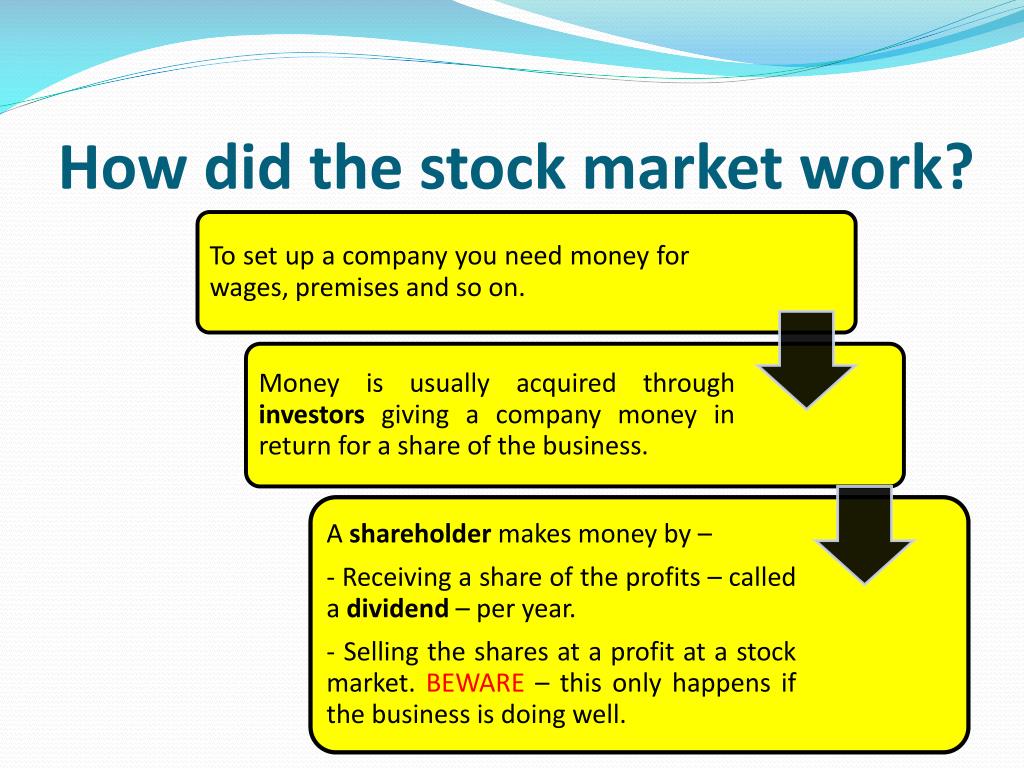Understanding the Basics of Stock Market Operations
The stock market is a complex system that enables the buying and selling of securities, such as stocks, bonds, and other investment instruments. At its core, the stock market provides a platform for companies to raise capital by issuing shares of stock to the public, while also allowing investors to participate in the growth and profits of these companies. To understand how the stock market works, it’s essential to grasp the different types of securities that are traded, including common stocks, preferred stocks, bonds, and exchange-traded funds (ETFs).
Common stocks represent ownership in a company and give shareholders voting rights and the potential to receive dividends. Preferred stocks, on the other hand, have a higher claim on assets and earnings than common stocks but typically do not come with voting rights. Bonds are debt securities issued by companies or governments to raise capital, offering regular interest payments and the return of principal at maturity. ETFs are investment funds that are traded on a stock exchange, like individual stocks, and track a particular index, sector, or asset class.
The stock market plays a vital role in facilitating the flow of capital between investors and companies, enabling the efficient allocation of resources and the creation of wealth. By understanding the basics of stock market operations, investors can make informed decisions about their investments and navigate the complex world of securities with confidence. Whether you’re a seasoned investor or just starting to explore the stock market, grasping the fundamentals of how it works is essential to achieving your financial goals.
So, how does the stock market work? In essence, it’s a platform that brings together buyers and sellers of securities, enabling them to trade with each other. The stock market is governed by a set of rules and regulations that ensure fair trading practices and protect investors. By understanding the mechanics of the stock market, investors can unlock the secrets of successful investing and achieve their financial objectives.
How Stock Exchanges Work: A Behind-the-Scenes Look
Stock exchanges, such as the New York Stock Exchange (NYSE) and NASDAQ, play a crucial role in facilitating the buying and selling of securities. These exchanges provide a platform for companies to list their shares, enabling investors to trade them. But have you ever wondered how stock exchanges work? To understand how the stock market works, it’s essential to delve into the inner workings of these exchanges.
At the heart of every stock exchange are brokers, dealers, and market makers. Brokers act as intermediaries between buyers and sellers, executing trades on behalf of their clients. Dealers, on the other hand, buy and sell securities from their own inventory, providing liquidity to the market. Market makers are specialized dealers who quote both a buy and sell price for a security, ensuring that there is always a market for the security.
The process of trading on a stock exchange involves several steps. First, a buyer or seller submits an order to a broker, specifying the security they want to trade, the quantity, and the price. The broker then sends the order to the exchange, where it is matched with a corresponding order from another party. Once the trade is executed, the exchange notifies the broker, who then confirms the trade with the client.
Stock exchanges also play a critical role in maintaining market liquidity. Market makers and dealers provide liquidity by buying and selling securities, ensuring that there is always a market for the security. This enables investors to buy and sell securities quickly and efficiently, which is essential for maintaining market stability.
In addition to facilitating trading, stock exchanges also provide a range of other services, including listing and delisting companies, monitoring trading activity, and enforcing trading rules. These services help to maintain the integrity of the market and ensure that investors have confidence in the trading process.
By understanding how stock exchanges work, investors can gain a deeper appreciation for the mechanics of the stock market. Whether you’re a seasoned investor or just starting to explore the stock market, knowing how stock exchanges operate can help you make more informed investment decisions and navigate the complex world of securities with confidence.
The Role of Supply and Demand in Shaping Stock Prices
The stock market is a dynamic system where the forces of supply and demand interact to determine the prices of securities. Understanding how supply and demand shape stock prices is crucial to grasping how the stock market works. The law of supply and demand states that the price of a security will adjust to a point where the quantity of shares that investors are willing to buy (demand) equals the quantity of shares that investors are willing to sell (supply).
When demand for a security is high, and supply is low, the price of the security tends to rise. Conversely, when demand is low, and supply is high, the price of the security tends to fall. This fundamental principle of economics plays out in the stock market every day, as investors buy and sell securities based on their expectations of future price movements.
Market forces, such as economic indicators, company performance, and investor sentiment, also influence the price of stocks. Economic indicators, such as GDP growth, inflation, and interest rates, can impact the overall direction of the stock market. Company performance, including earnings reports and revenue growth, can influence the price of individual stocks. Investor sentiment, including attitudes towards risk and market trends, can also drive price movements.
For example, if a company reports strong earnings growth, investors may become more optimistic about the company’s future prospects, leading to increased demand for the stock and a higher price. Conversely, if a company reports weak earnings, investors may become more pessimistic, leading to decreased demand and a lower price.
Understanding the role of supply and demand in shaping stock prices is essential to making informed investment decisions. By analyzing market forces and economic indicators, investors can gain insights into the potential direction of the stock market and make more informed decisions about their investments.
So, how does the stock market work in terms of supply and demand? In essence, it’s a constant interplay between buyers and sellers, with prices adjusting to reflect changes in demand and supply. By grasping this fundamental concept, investors can better navigate the complex world of securities and make more informed decisions about their investments.
How to Buy and Sell Stocks: A Step-by-Step Guide
Buying and selling stocks can seem like a daunting task, especially for those new to the stock market. However, understanding the process can help investors make informed decisions and navigate the market with confidence. To answer the question of how does stock market work, it’s essential to delve into the mechanics of buying and selling stocks.
The first step in buying or selling stocks is to open a brokerage account with a reputable online broker. This account will serve as a platform to execute trades, monitor portfolio performance, and manage investments. Investors can choose from various types of brokerage accounts, including individual, joint, or retirement accounts.
Once the account is set up, investors can fund it by depositing money via wire transfer, check, or electronic funds transfer. The funds will be used to purchase stocks, and the account will be used to hold the investments.
When buying stocks, investors can place different types of orders, including:
- Market order: An order to buy or sell a stock at the current market price.
- Limit order: An order to buy or sell a stock at a specific price or better.
- Stop-loss order: An order to sell a stock when it falls to a certain price to limit losses.
Investors can also choose from various trading platforms, including online trading platforms, mobile apps, or broker-assisted trading. Each platform offers different features, tools, and fees, so it’s essential to choose one that aligns with investment goals and strategies.
When selling stocks, investors can follow the same process as buying, but in reverse. They can place a sell order, specifying the number of shares to sell and the type of order. The brokerage firm will execute the trade, and the proceeds will be deposited into the investor’s account.
It’s essential to note that buying and selling stocks involves fees and commissions, which can eat into investment returns. Investors should carefully review the fees associated with their brokerage account and trading platform to ensure they are getting the best value.
In conclusion, buying and selling stocks is a straightforward process that requires a basic understanding of the stock market and trading platforms. By following these steps and choosing the right brokerage account and trading platform, investors can navigate the market with confidence and make informed investment decisions.
Understanding Stock Market Indices and Averages
Stock market indices and averages are essential tools for investors to track market performance and make informed investment decisions. These indices provide a snapshot of the overall market, allowing investors to gauge the performance of different sectors and industries. To understand how does stock market work, it’s crucial to comprehend the concept of stock market indices and averages.
A stock market index is a statistical measure that represents the performance of a particular segment of the stock market. It’s a basket of stocks that are selected based on specific criteria, such as market capitalization, sector, or geographic location. The most widely followed stock market indices include the S&P 500, Dow Jones Industrial Average, and NASDAQ Composite.
The S&P 500, for example, is a market-capitalization-weighted index that tracks the performance of the 500 largest publicly traded companies in the US. The index is calculated and maintained by S&P Dow Jones Indices, a leading provider of financial market indices. The S&P 500 is widely regarded as a benchmark for the US stock market, and its performance is closely watched by investors and financial analysts.
The Dow Jones Industrial Average (DJIA), on the other hand, is a price-weighted index that tracks the performance of 30 of the largest and most widely traded stocks in the US. The DJIA is calculated and maintained by S&P Dow Jones Indices and is often referred to as the “Dow.” The DJIA is a widely followed index, and its performance is often seen as a barometer of the overall US stock market.
Stock market averages, such as the S&P 500 and DJIA, are calculated using a specific methodology. The calculation involves taking the total market capitalization of the constituent stocks and dividing it by a divisor, which is adjusted periodically to account for changes in the market capitalization of the constituent stocks. The resulting value is the index value, which is then used to calculate the percentage change in the index over time.
Understanding stock market indices and averages is essential for investors to make informed investment decisions. By tracking the performance of these indices, investors can gain insights into the overall market trend and make adjustments to their investment portfolios accordingly. Additionally, stock market indices and averages provide a benchmark for investors to evaluate the performance of their individual stocks and portfolios.
In addition to the S&P 500 and DJIA, there are many other stock market indices and averages that track specific sectors, industries, or geographic regions. These indices provide a more nuanced view of the market and allow investors to focus on specific areas of interest. By understanding the different types of stock market indices and averages, investors can gain a deeper understanding of the market and make more informed investment decisions.
Risk Management Strategies for Stock Market Investors
Risk management is a crucial aspect of stock market investing, as it helps investors mitigate potential losses and maximize returns. Understanding how does stock market work is essential to developing effective risk management strategies. In this article, we will discuss the importance of risk management in stock market investing and provide tips on how to manage risk.
Diversification is a key risk management strategy that involves spreading investments across different asset classes, sectors, and geographic regions. By diversifying a portfolio, investors can reduce their exposure to any one particular stock or market, thereby minimizing potential losses. For example, an investor who owns a portfolio of stocks from different sectors, such as technology, healthcare, and finance, can reduce their risk by spreading their investments across different areas.
Hedging is another risk management strategy that involves taking a position in a security that offsets potential losses in another security. For example, an investor who owns a stock that is sensitive to interest rate changes can hedge their position by buying a bond that is inversely correlated with interest rates. This way, if interest rates rise and the stock price falls, the bond price will rise, offsetting the loss.
Stop-loss strategies are also an effective way to manage risk in stock market investing. A stop-loss order is an instruction to sell a stock when it falls to a certain price, thereby limiting potential losses. For example, an investor who buys a stock at $100 can set a stop-loss order at $90, so that if the stock price falls to $90, the stock will be sold, limiting the loss to $10.
Position sizing is another important risk management strategy that involves determining the optimal amount of capital to allocate to a particular trade. By sizing positions correctly, investors can manage their risk and maximize their returns. For example, an investor who has a $10,000 portfolio can allocate 2% of their capital to a particular trade, thereby limiting their potential loss to $200.
Risk management is an ongoing process that requires continuous monitoring and adjustment. Investors should regularly review their portfolios and adjust their risk management strategies as needed. By staying informed about market conditions and adjusting their risk management strategies accordingly, investors can minimize potential losses and maximize their returns.
In addition to these risk management strategies, investors can also use technical analysis and fundamental analysis to make informed investment decisions. Technical analysis involves studying charts and patterns to identify trends and predict future price movements, while fundamental analysis involves studying a company’s financial statements and other data to estimate its future performance.
By combining these risk management strategies with technical and fundamental analysis, investors can develop a comprehensive approach to managing risk in the stock market. By understanding how does stock market work and using these strategies, investors can minimize potential losses and maximize their returns.
The Impact of Economic Indicators on the Stock Market
Economic indicators play a significant role in shaping the stock market, as they provide valuable insights into the overall health of the economy. Understanding how does stock market work requires a grasp of the relationship between economic indicators and the stock market. In this article, we will examine the impact of economic indicators on the stock market and explain how they influence investor sentiment and stock prices.
Gross Domestic Product (GDP) is a key economic indicator that measures the total value of goods and services produced within a country. A high GDP growth rate is often seen as a positive indicator for the stock market, as it suggests a strong economy and increased corporate earnings. Conversely, a low GDP growth rate can lead to decreased investor confidence and lower stock prices.
Inflation is another important economic indicator that affects the stock market. High inflation can erode the purchasing power of consumers and reduce corporate profits, leading to lower stock prices. On the other hand, low inflation can lead to increased consumer spending and higher corporate profits, resulting in higher stock prices.
Interest rates are also a crucial economic indicator that influences the stock market. Low interest rates can make borrowing cheaper and increase consumer spending, leading to higher stock prices. However, high interest rates can make borrowing more expensive and reduce consumer spending, resulting in lower stock prices.
Unemployment rates are another economic indicator that affects the stock market. Low unemployment rates can lead to increased consumer confidence and higher stock prices, while high unemployment rates can lead to decreased consumer confidence and lower stock prices.
The stock market is also influenced by economic indicators such as the Consumer Price Index (CPI), the Producer Price Index (PPI), and the Institute for Supply Management (ISM) manufacturing index. These indicators provide valuable insights into the overall health of the economy and can influence investor sentiment and stock prices.
Investors should closely monitor economic indicators to make informed investment decisions. By understanding the relationship between economic indicators and the stock market, investors can adjust their portfolios accordingly and maximize their returns. For example, if an investor expects a high GDP growth rate, they may invest in stocks that are likely to benefit from a strong economy.
In addition to economic indicators, investors should also consider other market forces that can influence stock prices, such as company performance, investor sentiment, and global events. By taking a comprehensive approach to investing, investors can make informed decisions and achieve their financial goals.
Understanding the impact of economic indicators on the stock market is essential for investors to make informed decisions. By monitoring economic indicators and adjusting their portfolios accordingly, investors can maximize their returns and achieve their financial goals.
Staying Informed: Tips for Stock Market Research and Analysis
To make informed investment decisions, it’s essential to stay informed about the stock market. Understanding how does stock market work requires ongoing education and due diligence. In this article, we will provide tips on how to stay informed about the stock market, including research and analysis, news sources, and financial statements.
Research and analysis are critical components of stock market investing. Investors should conduct thorough research on the companies they are interested in investing in, including their financial statements, management team, and industry trends. This research can help investors identify potential opportunities and risks, and make informed decisions about their investments.
There are many news sources available that provide valuable information about the stock market. Investors can stay informed about market trends and news by reading financial newspapers, such as The Wall Street Journal and Financial Times, and online news sources, such as Bloomberg and CNBC. These sources provide up-to-date information about the stock market, including news, analysis, and commentary.
Financial statements are another important source of information for investors. Companies are required to file financial statements with the Securities and Exchange Commission (SEC), which provide detailed information about their financial performance. Investors can access these statements through the SEC’s website, and use them to analyze a company’s financial health and make informed investment decisions.
In addition to these sources, investors can also use online tools and resources to stay informed about the stock market. Many online brokerages and financial websites provide real-time market data, news, and analysis, which can help investors stay informed and make informed decisions.
It’s also important for investors to stay informed about market trends and analysis. Many financial websites and news sources provide analysis and commentary about the stock market, which can help investors understand market trends and make informed decisions. Investors can also use technical analysis tools, such as charts and indicators, to analyze market trends and identify potential opportunities.
Finally, investors should always be cautious when using online sources and tools. It’s essential to verify the accuracy of information and to be aware of potential biases and conflicts of interest. By being informed and doing their own research, investors can make informed decisions and achieve their financial goals.
Staying informed about the stock market requires ongoing education and due diligence. By using the tips and resources outlined in this article, investors can stay informed and make informed decisions about their investments. Remember, understanding how does stock market work is an ongoing process, and it’s essential to stay informed and adapt to changing market conditions.






